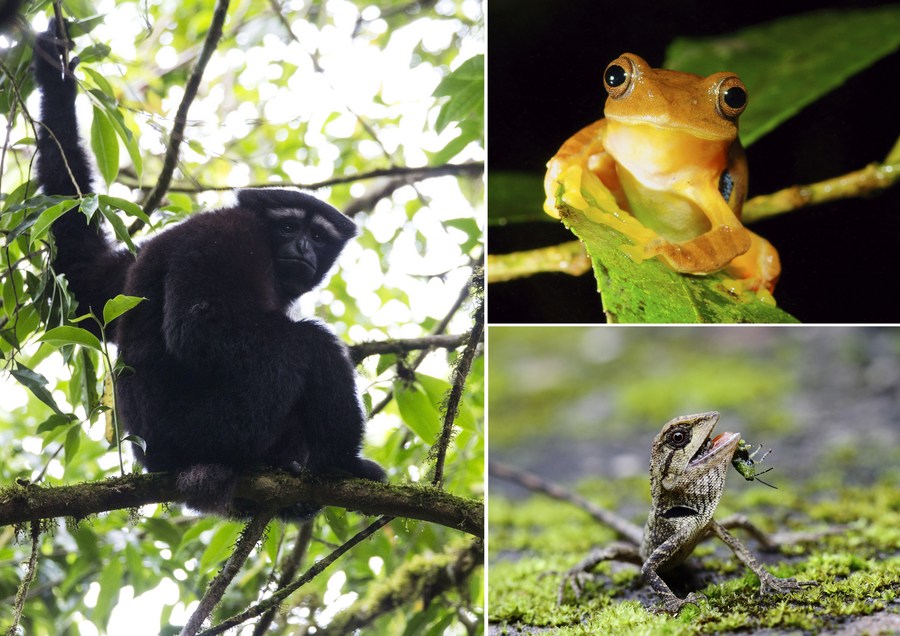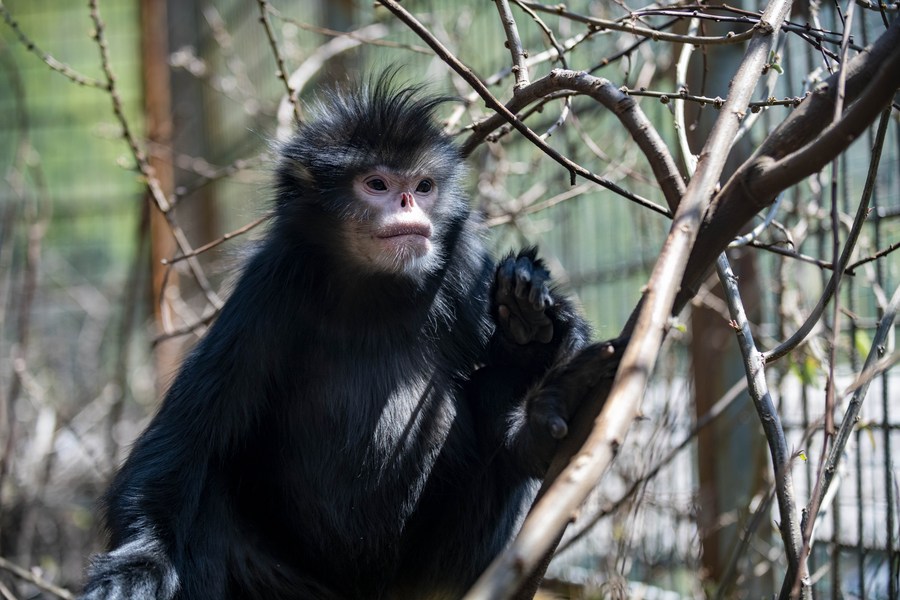Exploring China's biodiversity hotspot
-- The "Skywalker" gibbon is a new species found in the Gaoligong Mountains of China's Yunnan Province in 2017.
-- The Gaoligong Mountains are home to about 17 percent of higher plants, about 30 percent of mammals and 35 percent of birds in China.
-- Kunming, capital city of Yunnan, will hold the 15th meeting of the Conference of the Parties to the Convention on Biological Diversity (COP15) scheduled in October.
KUNMING, March 29 (Xinhua) -- Don't be confused if you are told that the "Skywalker" has been spotted amidst the forests of southwest China. The only difference -- instead of the Jedi in the "Star Wars" series, it refers to a gibbon species named by Chinese scientists.
The species, with white eyebrows, was found in the Gaoligong Mountains in 2017. The mountain range links three biodiversity hotspots including the Himalayas and vast mountains in southern Asia.
The total 34 biodiversity hotspots globally are areas that are both rich in life and at high risk of destruction, while in terms of the number of species, the Gaoligong Mountains are home to about 17 percent of higher plants, about 30 percent of mammals and 35 percent of birds in China.
The eco-region sits in Yunnan Province, with its capital Kunming chosen to be the host city of the 15th meeting of the Conference of the Parties to the Convention on Biological Diversity (COP15) scheduled in October.

Undated combo photo shows a "Skywalker gibbon" (L), a red-webbed tree frog (R, top) and a kind of wild tree lizard (R, bottom) in Gaoligong Mountain National Nature Reserve, southwest China's Yunnan Province. (Gaoligong mountain national nature reserve/Handout via Xinhua)
A HOTSPOT OF BIODIVERSITY
The Skywalker gibbon, or the Gaoligong Mountains hoolock gibbon, is morphologically and genetically distinct from other species, according to a research paper published in the American Journal of Primatology.
Their beards are completely black or brown instead of white, and white hair is absent in the suborbital area. They are far rarer than the giant pandas in terms of the population -- less than 150 in China, according to Fan Pengfei, one of the authors and a professor in life sciences at Sun Yat-sen University.
Fan said the English name "Skywalker" was inspired by Luke Skywalker from the "Star Wars." The name bears hopes of scientists that the species can survive tenaciously in the wild, as the corresponding Chinese name "Tian-xing" comes from a Chinese classic "I Ching," or "Book of Changes," he noted.
A family of three Skywalker gibbons resides near Nankang Village in the city of Baoshan.
Pointing to the gibbons foraging on the distant treetops, Yang Youshan, a forest ranger, read out their names so easily as if they were his friends.
It is not an easy task to track and monitor the gibbons as they are highly vigilant, wandering in the tree crown and jumping fast.
Yang has been following the traces of the gibbon family for 12 years, and the three have already got accustomed to the presence of Yang and his coworkers.
Patrols and scientific research monitoring works are of great significance in managing a nature reserve. Meanwhile, authorities have set up 29 vegetation sample plots, 22 plant sample plots and six wildlife monitoring spots, and installed more than 600 infrared cameras.
"We have to protect our green home like protecting our eyes," said He Guipin, who has spent 26 years exploring the forest.
He leads a patrol team of 20 people, managing and protecting over 53,300 hectares of forests in Gaoligong. They are responsible for protecting forest resources, preventing forest fires and cracking down on illegal logging and poaching.

He Guipin and six of his team members patrol in the Gaoligong Mountains, southwest China's Yunnan Province, on March 12, 2021. (Xinhua/Chen Xinbo)
In 2011, He and his colleagues took a photo of a black monkey. It was later confirmed as a new species of the golden monkey after DNA identification of extracted feces and hair.
The Chinese primate expert group named it "Nujiang River golden monkey." He deems his participation in the discovery and protection of the species the most fulfilling thing ever.
"This is the fifth golden monkey species in the world, and now it has become a star animal in Gaoligong while being under top-class protection," said He, noting that the population of such monkeys has risen from about 100 to 250, with their range of activities expanding.
Statistics show that since 1980, more than 620 new species of animals and plants have been discovered in Gaoligong, outnumbering any other eco-region in China.
Incomplete statistics also indicated that there are 5,728 species of higher plants, 205 species of mammals, 525 species of birds and 1,720 species of insects in Gaoligong, including more than 100 species of wild plants and animals under national-level protection.

A rescued Nujiang River golden monkey rests in a residence imitating wild environment at a protention center in the Gaoligong Mountains, southwest China's Yunnan Province, on March 12, 2021. (Xinhua/Chen Xinbo)
HARMONY BETWEEN HUMAN AND NATURE
Hou Tiguo, 52, lives in Baoshan's Baihualing, a village sitting at the eastern foot of the Gaoligong Mountains.
More than 520 bird species have been recorded in the village, accounting for over 30 percent of the total across the country, thus it is dubbed a top bird-watching destination.
But, bird watching didn't always thrive in the region, as the idea of this activity barely crossed the minds of locals earlier.
"When I was a child, I had no meat to eat. So I went up the mountain to shoot birds with a slingshot," Hou said.
But, 1989 was a turning point in his life. A traveler couple stopped by Hou's house and asked him where can they watch birds. He became their tour guide and took them around the area, receiving some tips in return. This serendipitous encounter inspired him to take up tour guiding as a profession.
As Hou's village gained more fame and received more tourists, Hou started to work as a "bird guide."
He discerned that wherever there was water, birds would come to bathe and quench their thirst. So, he built a "bird pond" by emulating the ecological system in a bid to provide more convenience for tourists to take photographs.
The eco-tourism mode is in the ascendant in recent years. Hou has rendered his services as a guide to tourists from over 100 countries and regions. Once he received so many guests in a single day that they were enough to occupy a plane cabin, he recalled with a sense of pride.

Photo taken on Dec. 4, 2020 shows Hou Tiguo (2nd R) at his "bird pond" with tourists in Baihualing, a village sitting at the eastern foot of the Gaoligong Mountains, Baoshan City, southwest China's Yunnan Province. (Xinhua/Hu Chao)
Hou's successful endeavors in tourism have set an example for his fellow villagers, and they have followed suit. Over 20 homestays have been built for tourists, and more than 60 people are providing tour guide services.
The featured bird watching tour has also boosted catering, homestay, backpacking and transportation services, generating over 10 million yuan (about 1.5 million U.S. dollars) every year for the village.
The first environment conservation organization of farmers in China was founded in the village in 1995. As of today, the number of its members has exceeded 150.
With thriving eco-tourism that has induced benefits for the village and more awareness of environmental protection, the bad practice of shooting birds has dissipated to oblivion.
Photos
Related Stories
- Biodiversity in Yangtze River boosted through protection
- Protecting biodiversity requires countries worldwide to uphold multilateralism: Chinese envoy
- China holds Man and the Biosphere Youth Forum on biodiversity
- Vice premier urges solid efforts for biodiversity conservation
- Biodiversity greatly improved in Hol Xil region, NW China
Copyright © 2021 People's Daily Online. All Rights Reserved.










